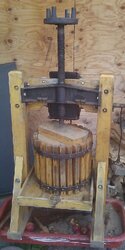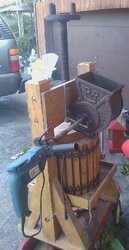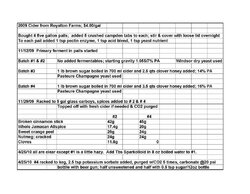I don't have the cider directions yet but found mead instructions and figured I'd post them anyway:
In answer to your question, I believe in Keeping it Simple. Boil the water (with part of a Camden tablet), add honey to 17.5% P.A., partially cool, pitch WL720 yeast, and wait.
Boil the Water
I boil the water with about 1/4 to 1/2 potassium metabisulfite (Camden) tablet per 5 gallons of water. This gets rid of chlorine and any chloramines. (In some systems, chloramine is added instead of chlorine, but even is chlorine systems, the chlorine can react with any protein (poly amino acids) and form some chloramines.)
Add Honey to 17.5% Potential Alcohol
Off the stove, I then pour the honey into the hot water or the hot water into the honey. In ALL of the mead I have ever made in the past 11 years, I have used/reused from a batch of White Labs WL720 - a sweet mead yeast that gives citrus tones during the fermentation. Some year I will try some other yeasts (as my son in Australia keeps proposing that I do), but I haven't found a listed flavor profile that is better than this yeast. I will provide a starter for anyone that wants what might now be a different yeast than I started with. Anyway, I know that the alcohol tolerance for this yeast is about 12% to 14% and I like my final mead to have residual sweetness of 3 1/2 to 5 1/2% potential alcohol (one of the three scales on almost all hydrometers). So, the last 300 to 400 pounds of honey I have made into honey water with potential alcohol of 17 1/2% at 68F (my basement temperature). {Note Well - MAKE SURE your final measurements are taken at 68 to 70F, because temperature has a DRAMATIC impact on the hydrometer readings. This should take about 3 pounds of honey per gallon, (Probably per gallon of honey water instead of per gallon of starting water - but I never weigh the honey - I just measure it with a hydrometer.)
Cool to at least 80F, Pitch, and then Wait
Need to cool a) so it doesn't break glass carboys and b) so it doesn't kill the yeast. I found it starts faster if the honey water is still warm. I siphon the honey water into the carboy because this tends to leave pollen, dirt, bee wings, etc. on the sides of the mixing container.
Options
If you want the fermentation to go faster, you can add yeast energizer and yeast nutrient either to the hot water or to the honey water at any time. Also an option is a drop of olive oil - which is said to provide starting material for the yeast walls. Literature claims 1 drop per 20 gallons, but I am sure a drop per carboy is fine. If you want you can stir, shake, or otherwise oxygenate the honey water. I started out using yeast energizer, yeast nutrient, magnesium sulfate (Epson salts), vitamin B, ascorbic acid, shaking to oxygenate, and so forth - but have lately (as least started out) making mead that could be entered as a "SHOW MEAD" - which is a mead made without any additional chemicals. I think the results may vary depending on the type of honey. Clover may require more chemicals - but they can be added if the fermentation sticks (in spite of what some people say). For a stuck fermentation, I will add some of the nutrient and/or other chemicals and stir to oxygenate (and bring to a slightly warmer location than my basement - or otherwise provide some extra heat). I figure if you can keep a half full bottle of finished mead in the fridge for 6 months, I really don't need to worry about a little oxygenation part way through the fermentation - which should still ferment out any bad products. My fermentations are slow and so is the clarification - but the results are good.
Consider some other types of honey. There is considerable difference in the final taste depending on the honey type. In addition to the 120 pounds of clover honey I bought on the SAAZ buy (all fermenting), I also have recently purchased 150 pounds of Tupelo (started another 10 gallons today) to go with my 3 or 4 pails of Orange Blossom honey and a couple of pails of Buckwheat honey. I do not recommend Golden Rod honey (I made the resulting mead into strawberry/cinnamon mead for a wedding). I bought the Clover honey primarily for base meads for my melomels and metheglins, but it can also be OK (but probably not extraordinary) for traditional meads
I almost always do all of my additions after the honey water has turned into mead. I know that I like the tart cherry flavor of cherries and not the fermented cherry flavor I would get if I added the cherries at the beginning. Unless you WANT the fermented flavor of additions (e.g. wine instead of grape), wait till you have mead. I have yet to hear if there is any change in the fermented vs. non-fermented flavor of spices, but why take a chance. I know most fruit flavors change dramatically. Also, with 12% alcohol, you don't need to worry much about contamination/cleaning/sterilization of fruit/teas/spices.




 That is the first time I have had it that fresh and it is pretty agreeable.
That is the first time I have had it that fresh and it is pretty agreeable.
 Anyone got or can tell me where to get a directions on how to make it?
Anyone got or can tell me where to get a directions on how to make it?